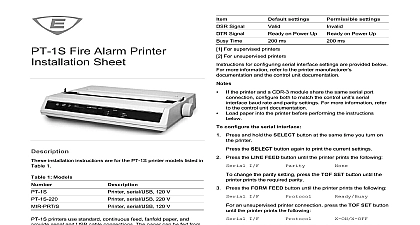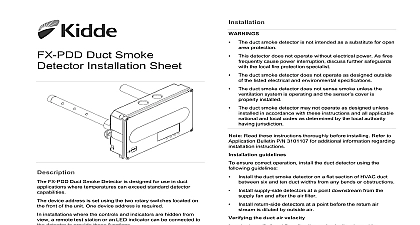Kidde 3102002-EN R02 260-CO SafeAir Carbon Monoxide Detector Installation Sheet

File Preview
Click below to download for free
Click below to download for free
File Data
| Name | kidde-3102002-en-r02-260-co-safeair-carbon-monoxide-detector-installation-sheet-2031486957.pdf |
|---|---|
| Type | |
| Size | 774.05 KB |
| Downloads |
Text Preview
SafeAir Carbon Monoxide Detector Sheet about carbon monoxide Read these installation instructions in their entirety before Leave these instructions with the owner user this CO detection equipment product is intended for use in indoor locations of units It is not designed to comply with Safety and Health Administration OSHA or industrial standards detector only indicates the presence of CO gas at the Carbon monoxide gas may be present in other to properly install test and maintain a CO detector cause it to fail potentially resulting in loss of life of this detector is not a substitute for proper use and maintenance of fossil fuel burning including appropriate ventilation and exhaust reduce the risk of CO poisoning test the detector when not in use for 10 days or more detector does not operate without electrical power As frequently cause power interruption discuss further with the authority having jurisdiction AHJ Do not paint the detector Regulatory code may require that the system generate a temporal code TC3 for fire alarms and a four temporal code TC4 for CO alarms CO sensor is calibrated at the factory CO sensitivity set to conform to UL 2034 requirements and cannot be by the user See on page 7 for sensitivity values reduce the likelihood of nuisance alarms ventilate spaces when using household cleaning or similar contaminants If a detector has been to such contaminants test it promptly afterwards of CO poisoning following symptoms related to CO poisoning should be with all occupants of the protected site monoxide alarm procedure The carbon monoxide CO alarm indicates the of CO which can kill you If the alarm signal sounds times pauses for five seconds and then repeats the Press the Test Hush button at the detector or at the panel Move to fresh air immediately outdoors or by an open or window Check that all persons are accounted for not reenter the premises or move away from the open or window until emergency services responders have the premises have been aired out and your remains in normal condition Call emergency services the fire department or 911 After following steps 1 to 3 if your detector reactivates steps 1 to 3 and call a qualified appliance to check for sources of CO from fuel burning and appliances and to inspect for proper of this equipment problems are found during this inspection have the serviced immediately Note any combustion not inspected by the technician and consult the directly for more information about CO for the equipment Make sure that motor vehicles not and have not been operating in an attached or adjacent to the premises 2013 UTC Fire Security All rights reserved 8 3102002 EN REV 02 ISS 15FEB13 exposure Slight headache nausea vomiting fatigue nose sore eyes often described as flu like symptoms exposure Severe throbbing headache dizziness confusion fast heart rate exposure Unconsciousness brain damage cardiorespiratory failure death cases of reported CO poisoning indicate that while are aware they are not well they become so that they are unable to save themselves by either the building or calling for assistance Young children pets may be the first affected sources CO sensor in this detector is designed to detect carbon gas from any source of combustion It is not to detect fire smoke or any other gas Potential CO include fuel fired appliances e g space heater water heater range oven clothes dryer other of combustion e g kerosene burning stove or heater gas log fireplace or internal combustion engines addition excessive exhaust spillage or reverse venting of appliances can produce dangerous transient of CO This can be caused by external conditions Wind direction velocity or a combination of both high gusts of wind or insufficient draft in vent inversions that can trap exhaust gases near ground Negative pressure differential resulting from the use of fans operation of several fuel burning appliances for limited internal air pipe connections vibrating loose from dryers or water heaters Obstructions in vent pipes or unconventional vent pipe which can amplify the above situations designed or maintained chimneys and or vents operation of unvented fossil fuel burning devices oven fireplace etc cars in an open or closed attached garage or near premises limitations of CO detectors detector is designed to protect individuals from the acute of CO exposure It will not fully safeguard individuals specific medical conditions People with special medical should consider using specialized detection devices less than 30 ppm parts per million alarming capabilities in doubt consult a medical practitioner the unit is in trouble or at the end of its life it may not sense and cannot be relied upon to monitor CO levels Replace CO detector within ten years from the date of manufacture when the detector indicates an end of unit life condition comes first detector installed outside a bedroom may not awaken a Normal noise due to stereos television etc may also the detector from being heard if distance or closed or closed doors muffle the sounder This unit is not for the hearing impaired detectors are not a substitute for designated life safety Though these detectors will warn against increasing levels we do not warrant or imply in any way that they will lives from CO poisoning They should only be as an integral part of a comprehensive safety locations a suitable location is critical to the operation of CO Figure 1 shows appropriate detector locations 1 Detector locations Recommended CO detector location 260 CO SafeAir Carbon Monoxide Detector detects monoxide gas monitors the levels of CO gas and early warning when potentially dangerous levels exist It a built in sounder that acts as a primary alarm device The control panel is the supplementary notification device 260 CO SafeAir Carbon Monoxide Detector is a four wire that uses a Class 2 output from a control panel listed to UL 985 or 864 standards or from an auxiliary power It is intended for indoor dwelling unit applications in residential and commercial occupancies including single multiple family residential occupancies hotel rooms dorm and other areas approved by the authority having AHJ 260 CO detector meets UL 2075 Standard for Gas and Detectors and Sensors It does not detect fire smoke or other gases and Signals 260 CO detector produces varying sounds in addition to alarm signal It also flashes a multicolored LED to indicate detector status Table 1 lists status indications of the 8 3102002 EN REV 02 ISS 15FEB13 1 Detector status indications air 1 pulse every seconds pulses with sound pulses with four rapid beeps every seconds or every minute five minutes in the alarm one rapid beep every seconds of unit life Amber pulses with one rapid beep every seconds of power No LED LED sounder four rapid beeps every seconds or every minute five minutes 85 dB temporal four alarm The 85 dB sounder a distinctive temporal four alarm notification that is to differentiate from smoke detector notification devices alarm beeps four times pauses five seconds and then the pattern of unit life indicator The detector uses both a flashing LED and intermittent sounder chirps one rapid beep 15 seconds to indicate that the detector needs The detector also activates the trouble relay which be monitored by a panel As soon as possible replace a that reaches end of life because it may no longer


